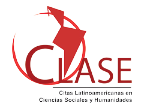Una investigación teórica sobre relaciones semánticas partitivas y su aplicación en Sistemas de Organización del Conocimiento
DOI:
https://doi.org/10.5433/1981-8920.2019v24n2p31Palabras clave:
Ontologías, Relaciones Semánticas, Relaciones Parte-todoResumen
Introducción: Las relaciones semánticas son esenciales para la Representación del Conocimiento, un campo de investigación cada vez más relevante, a partir del advenimiento de la Web Semántica. La Ciencia de la Información tiene un largo historial de estudio y uso de relaciones semánticas en los diversos contextos en que Sistemas de Organización del Conocimiento (SOCs) son diseñados y construidos. Sin embargo, son pocos los estudios detallados sobre la relación semántica parte-todo, también conocida como relación partitiva. Objetivo: el presente artículo objetiva una descripción bien fundamentada de la relación partitiva, a partir de abordaje interdisciplinario que envuelve sus orígenes lingüística y filosófica. Metodología: para alcanzar el objetivo propuesto, se describen y se caracterizan las principales formas por las cuales relaciones partitivas se manifiestan – la meronimia, no formal y lingüística; y la mereología, formal y lógica, distinguiendo por la propiedad de la transitividad. Resultados: a partir de la distinción mencionada, se sugiere criterio pragmático al decidir qué abordaje de relación partitiva es adecuada cuando se construyen ontologías y tesauros. Conclusiones: se concluye que las relaciones formales son, de hecho, más estrictas, y se puede afirmar que están incluidas en las relaciones no formales, pero que el uso de las relaciones formales en ontologías requiere cuidados muchas veces descuidados por profesional de la Ciencia de la Información.
Descargas
Citas
BITTNER, T. Mereology 2. 2011. Disponível em: http://ontology.buffalo.edu/smith/courses03/tb/Mereology2.pdf. Acesso em: 15 ago. 2010.
BIEDERMAN, I.A Recognition-by-Components: a theory of human image understanding. Psychological Review, v. 94, p.115-147, 1987.
BIERWISCH, M.; HEIDOLPH, K. E. Progress in linguistics: a collection of papers. The Hague: Mouton Publishers, 1970.
CHAFFIN, R.; HERRMANN, D. J.; WINSTON, M. An empirical taxonomy of part-whole relations: effects of part-whole type on relation identification. Language and Cognitive Processes, v. 3, n.1, p. 17-48, 1988.
CROFT, W.; CRUSE, D. A. Cognitive Linguistics. Cambridge: Cambridge University Press, 2004.
CRUSE. D. A. Lexical semantics. Cambridge: Cambridge University Press, 1986
CRUSE, D. A. On the transitivity of the part-whole relation. Journal of Linguistics, v. 15, n. 1, p. 29–38, 1979.
FLAVELL, J. H.; MARKMAN, E. M. Cognitive development. New York: Wiley, 1983.
GERSLT, P.; PRIBBENOW, S. Midwinters, end games and body parts: a classification of part-whole relations. Int. J. Human-Computer Studies, v. 43, p. 865-889, 1995. Disponível em: http://www.ontology.buffalo.edu/smith/courses03/tb/PribbenowMidwinters.pdf. Acesso em: 12 fev. 2013.
GOTTS, N. M.; COHN, A. G. A mereological approach to representing spatial vagueness. School of Computer Studies, s.n, p. 246-255. 1995. Disponível em: http://www.qrg.northwestern.edu/papers/Files/qrworkshops/QR95/Gotts_poster_1995_Mereological_Approach_Spatial_Vagueness.pdf. Acesso em: 5 abr. 2013.
GUIZZARDI, G. The problem of transitivity of part-whole relations in conceptual modeling revisited. 2009. Disponível em: http://www.inf.ufes.br/~gguizzardi/CAISE2009CR.pdf. Acesso em: 6 abr. 2013.
HJORLAND, B. Semantics and knowlegde organization. Annual Review of Information Science and Technology, v. 41, n.1, p. 367-405, 2007.
JANSEN, L. Categories: the Top-Level Ontology. In: SMITH, B.; MUNN, K. (Ed.). Applied Ontology: an introduction. Frankfurt: Ontos Verlag, 2008. p. 173- 196.
JOHANSSON, I. On the transitivity of the parthood relations, 2004. Disponível em: http://hem.passagen.se/ijohansson/function2.PDF. Acesso em:12 maio 2018.
KEET, C. M.; ARTALE, A. Representing and reasoning over a taxonomy of part-whole relations. Applied Ontology, v. 3, n. 1, p. 91-110, 2008.
KHOO, C. S. G.; NA, J. Semantic relations in Information Science. Annual Review of Information Science and Technology, v. 40, n.1, p.157-228, 2006.
LEONARD, H. S.; GOODMAN, N. The calculus of individuals and its uses. Journal of Symbolic Logic, v.5, n. 2, p. 45-55, 1940.
LEŚNIEWSKI, S. Foundations of the general theory of Sets I. In: LEŚNIEWSKI, S., SURMA, S. J.; SRZEDNICKI, J.; BARNETT, D. I.; RICKEY, F. V. (Ed.). Collected Works. Dordrecht: Kluwer, p. 129-173, 1992.
LYONS, J. Semantics: volume 1. Cambridge: Cambridge University Press. 1977.
LYONS, J. Introduction to theoretical linguistics. Cambridge: Cambridge University Press, 1968.
MILLER, G. A.; JOHNSON-LAIRD, P. N. Language and perception. Cambridge: Belknap Press, 1976.
MORRIS, M. An introduction to the Philosophy of Language. Cambridge: Cambridge University Press, 2007.
MURPHY, M. L. Semantic relations and the lexicon: antonymy, synonymy, and other paradigms. Cambridge: Cambridge University Press, 2003.
PRIBBENOW, S. Meronymic relationships: from classical mereology to complex part-whole relations. In: GREEN, R.; BEAN, C.A.; MYAENG, S.H. (eds.). The semantic of the relationships: an interdisciplinary perspective. Dordrecht: Kluwer Academic Publishers, 2002, p. 35-50.
RESCHER, N. Axioms for the part-whole relation. Philosophical Studies, v. 6, p. 8-11, 1955.
SCHULZ, S.; STENZHORN, H.; BOEKER, M.; SMITH, B. Strenghts and limitations of formal ontologies in the biomedical domain. Reciis-Electronic Journal of Communication, Information and Innovation in Health, v. 3, n. 1, p. 31-45, 2009.
SIMONS, P. Parts: a study in ontology. Oxford: Oxford University Press, 1987.
SMITH, B. Ontology and Logistic analysis of reality. 1993. Disponível em: http://ontology.buffalo.edu/smith/articles/Olar.pdf. Acesso em: 3 dez. 2009.
SMITH, B.; KUNNE, W. Parts and moments: studies in logic and formal ontology. Munich: Philosophia Verlag, 2004.
SMITH, B.; MUNN, K. Applied ontology: an introduction. Frankfurt: Ontos Verlag, 2008.
SOUZA, R. R; TUDHOPE, D.; ALMEIDA, M. B. Towards a taxonomy of KOS: dimensions for classifying knowledge organization systems. Knowledge Organization, v. 39, n. 3, p. 179-200, 2012.
STOCK, W. G. Concepts and semantic relations in information science. Journal of the American Society for Information Science and Technology, v. 61, n. 10, p. 1951-1969, 2010.
TVERSKY, B. Where partonomies and taxonomies meet. In: TSOHATZIDIS (ed.). Meanings and prototypes: studies on linguistic categorization. London: Routledge, 1990. p. 334-344.
TVERSKY, B.; HEMENWAY, K. Objects, parts and categories. Journal of Experimental Psychology: General, v. 113, n. 2, p. 169-193, 1984.
VARZI, A. C. Mereology. 2009. Disponível em: http://plato.stanford.edu/entries/mereology/. Acesso em: 20 dez. 2012.
VARZI, A. C. Parts, wholes, and part-whole relations: the prospects of mereotopology. Data and Knowledge Engineering, v. 20, n. 3, p. 259-286, 1996.
VARZI, A. C. A note on the transitivity of parthood. Applied Ontology, v.1, n. 2, p. 141-146, 2006.
WANNER, L. Lexical functions in lexicography and natural language processing. Amsterdan: John Benjamins Publishing, 1996.
WELLER, K.; STOCK, W. G. Transitive meronymy: automatic concept-based query expansion using weighted transitive part-whole relations. Information - Wissenschaft & Praxis, v. 59, n. 3, p. 165-170, 2008.
WINSTON, M. E.; CHAFFIN, R.; HERRMANN, D. A taxonomy of part-whole relations. Cognitive Science, v. 11, p. 417-444, 1987.
Descargas
Publicado
Cómo citar
Número
Sección
Licencia
A revista se reserva o direito de efetuar, nos originais, alterações de ordem normativa, ortográfica e gramatical, com vistas a manter o padrão culto da língua e a credibilidade do veículo. Respeitará, no entanto, o estilo de escrever dos autores. Alterações, correções ou sugestões de ordem conceitual serão encaminhadas aos autores, quando necessário.
O conteúdo dos textos e a citação e uso de imagens submetidas são de inteira responsabilidade dos autores.
Em todas as citações posteriores, deverá ser consignada a fonte original de publicação, no caso a Informação & Informação.












